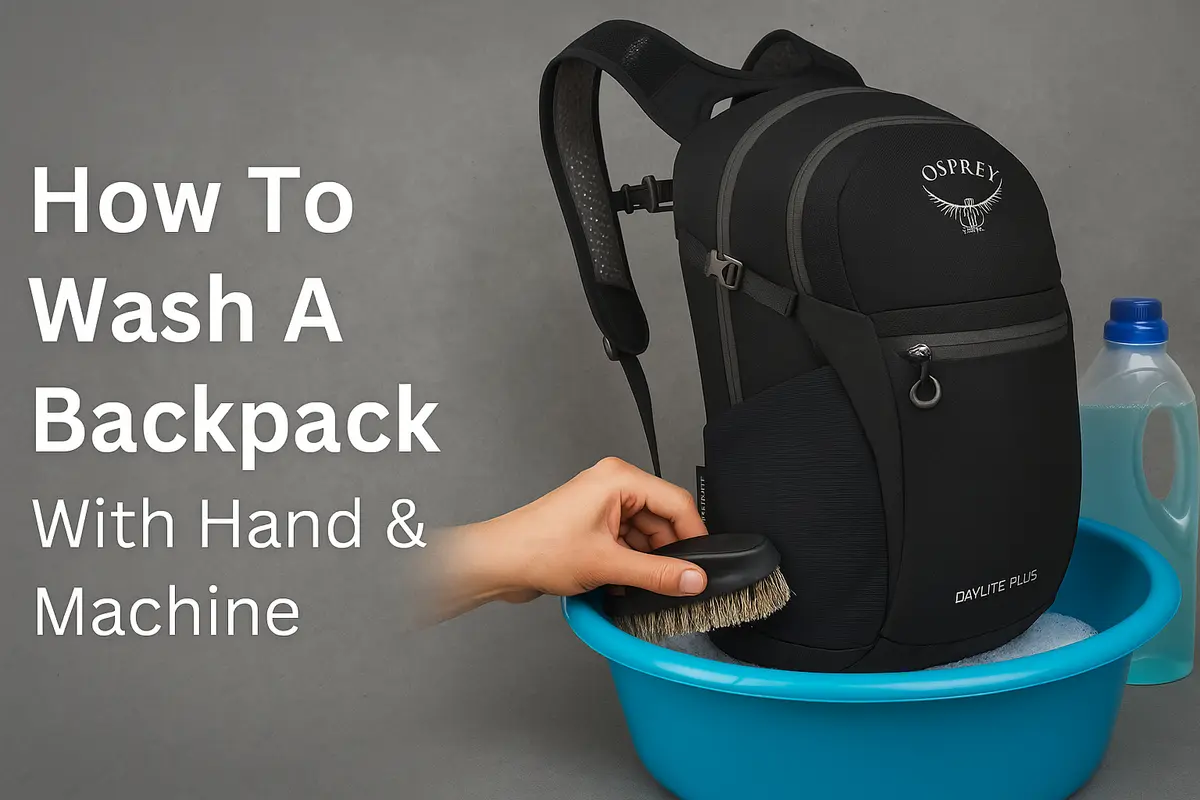I recently went on a hiking trip with some friends, and like always, I took my Osprey Daylite Plus backpack. We cooked in the mountains, sat around, and placed our bags on the ground, rocks, and even near the fire while making tea. After a few trips like that, my backpack started looking dirty and smelling a bit off.
As someone who knows the backpacks materials well can describe it better and give great tips on how to wash a backpack with hands and with machine. In this article, I’ll show you step by step how to wash a backpack, either by hand or in a washing machine.
| Material | Cleaning Method | Important Note |
|---|---|---|
| Nylon | Hand wash or gentle machine wash | Use cold water and mild detergent only |
| Polyester | Machine or hand wash | Avoid hot water to protect the fabric |
| Waxed Canvas | Hand wash only | Use cold water and a soft brush; avoid soap to preserve wax |
| Leather Trim | Hand wash carefully | Use a damp cloth and leather cleaner on trim; avoid soaking |
Prepare the Backpack for Cleaning:
Before Washing a backpack you need to take care of various things, the top most important things that everyone should look for are mentioned below:
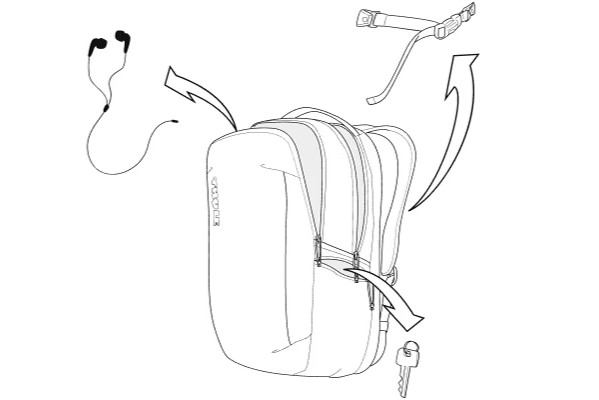
Remove Detachable Parts:
Take off hip belts, shoulder straps, or any frame sheets if your pack has them. These should be cleaned separately, because the palstic parts attached with them might break in machine or while washing with hand.
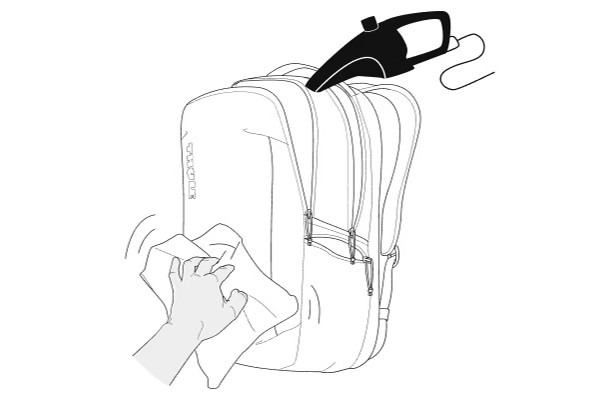
Empty and Remove Dirt:
Before washing, get your backpack ready. Start by emptying every pocket and compartment. Dump out all contents, shake the bag upside-down, and use a vacuum or brush to remove loose dirt and crumbs. Check hidden spots like mesh pockets or under flaps.

Inspect Care Labels:
Next, inspect care labels. Most packs have a tag inside that tells you how to wash them. If the label says “hand wash only” or “do not machine wash,” follow that advice. If there’s no label, consider the paragraph written below in this article for hand wash.
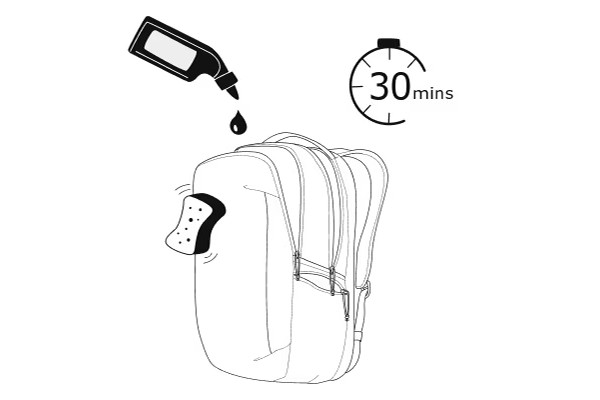
Treat Stains:
Finally, treat stains before washing. For visible spots, dab on a little mild detergent or stain remover and gently scrub with a soft brush. Let it sit for a few minutes. Avoid bleach unless you’re fighting mold on a white, colorfast pack. Once stains are pretreated, your backpack is ready for a full wash.
Backpack Cleaning Supply Guide:
Each backpack size and material demands it’s own careful cleaning essentials. Read the label on side of your bag to see the material with which it is made off, and then use our calculator to see how much water, detergent and time it will take to fully clean a dirty backpack.
| Size | Detergent Needed | Water Volume | Estimated Cleaning Time |
|---|---|---|---|
| Small (Under 20L) | 1 tsp (5 ml) | 2–3 L lukewarm water | 15–20 minutes |
| Medium (20–35L) | 1.5 tsp (7–8 ml) | 4–5 L lukewarm water | 20–30 minutes |
| Large (35L+) | 2 tsp (10 ml) | 6–8 L lukewarm water | 30–40 minutes |
Always follow the cleaning instructions given at the label or instruction book given withthe backpack at time of purchase.
How to Hand Wash a Backpack:
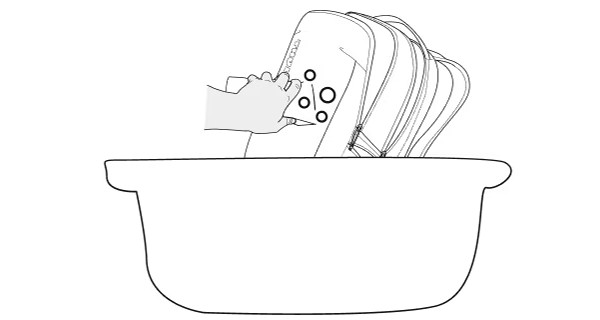
Hand washing is the safest way to clean most backpacks, especially those with water-resistant coatings or delicate trims. Here’s how to do it:
- Fill a tub with lukewarm water and mild detergent: Use a clean bathtub, large sink, or bucket. Fill it with about 5–6 inches of lukewarm water (not hot) and add a teaspoon of gentle detergent (free of dyes and additives). Too much detergent can be hard to rinse out, so a small amount is plenty.
- Submerge and scrub the backpack: Place the entire backpack in the water for atleast 7 mintues. Gently agitate it and use a soft sponge or cloth to scrub all areas, inside and out. Focus on straps, the back panel, and any dirty spots. A soft-bristle brush or old toothbrush is great for tougher stains or zipper teeth. Be careful not to scrub too hard, especially on mesh or padded areas, to preserve coatings.
- Rinse thoroughly: After washing, drain the soapy water and refill the tub with clean lukewarm water. Submerge and rinse the pack until all soap suds are gone. If you didn’t fully submerge it, you can also rinse by pouring fresh water in or using a shower spray. Wring out excess water by pressing or patting with your hands, but don’t wring aggressively, which can deform padding.
- Cleaning Zippers & Corners: Use a toothbrush for zippers and corners.
- Air-dry completely: Remove the backpack from water and gently shake off extra droplets. Tuck an absorbent towel inside and press it to soak up water. Then hang the pack to dry upside down. Choose a well-ventilated area away from direct sunlight. UV rays can weaken nylon and fade colors. Let it drip-dry fully (this may take a day or two). Leave pockets unzipped so air can circulate. Once bone dry, reattach all straps and use them as normal.
Hand-washing may take more time, but it protects water-repellant coatings and delicate parts. Osprey, for example, explicitly advises hand cleaning with warm soapy water and a sponge. This method is ideal for leather-trimmed or embellished backpacks too.
How to Machine Wash a Backpack:
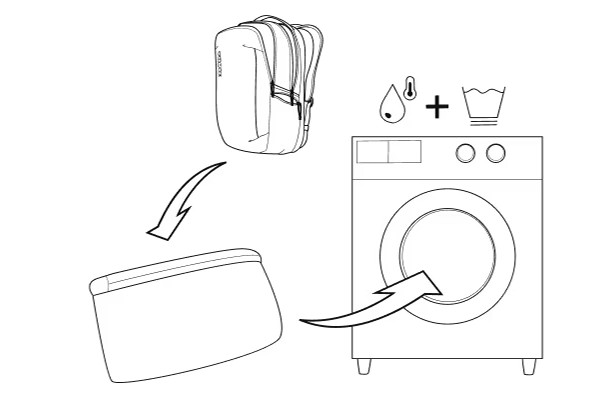
Some basic backpacks (usually nylon or polyester) can be safely machine washed, but only with caution. Always check the care label first. Here we have provided you information if machine wash is good for you bag or not, just select your bag material.
If your pack is sturdy fabric without glued-on patches, it may handle a gentle machine cycle.
Machinewash (Yes/No)
Check the Backpack material and follow the instruction accordingly:
- Nylon: ✅ Usually safe to machine wash. Use a gentle cycle with cold water.
- Polyester: ✅ Generally machine washable. Use mild detergent on a gentle cycle.
- Canvas (without leather): ⚠️ Can often be machine washed, but check the care tag first.
- Waxed Canvas: ❌ Do not machine wash. It can damage the wax coating.
- Leather Trim: ❌ Avoid machine washing. Hand wash only to protect leather.
- Full Leather: ❌ Never machine wash. Use leather cleaner only.
- Coated Fabrics (PU, DWR): ⚠️ May lose coating if machine washed. Hand washing is safer.
Machinewash Process:
Here are the steps:
- Protect the backpack: Turn the bag inside out or put it in a pillowcase or mesh laundry bag. This shields the backpack’s straps and hardware from snagging in the washer. Add a few towels to the load (with just the backpack) to balance the wash and cushion it.
- Use detergent: Pour a mild, additive-free detergent (about 1–2 tablespoons) into the machine. No bleach or fabric softener! Choose the machine’s gentlest or delicate cycle with cold or lukewarm water. A slow spin avoids tangles. Avoid high heat, use warm, not hot water.
- Air-dry the bag: When the cycle finishes, remove the backpack. Do not put it in the dryer, tumble heat will harm fabrics and plastic parts. Instead, shake out excess water, gently pat with a towel, and hang it upside-down to drip-dry. Leave all compartments open and hang in shade or indoors, as direct sun can fade and weaken materials.
By following these steps, you can machine-wash many daypacks without damage. Whirlpool experts note that nylon or canvas packs usually tolerate a washer on gentle settings. Nylon backpacks are often colorfast enough to machine wash, even if labeled “do not bleach”.
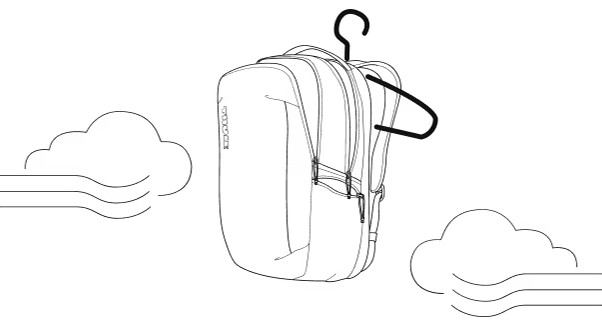
Backpack Cleaning Hacks:
Here are some extra tips and tricks to make your backpack cleaning easier:
- Spot Treatment: Act fast on stains. A mixture of mild detergent and water, or even white vinegar, works wonders on mildew or sweat stains. Dab and scrub with a soft brush, then rinse.
- Deodorize: To remove lingering odors, sprinkle baking soda inside the dry pack, let it sit overnight, then shake or vacuum it out. Baking soda neutralizes smells and is safe on fabrics.
- Brush and vacuum: Even before washing, use a vacuum with a crevice tool to suck up fine debris from seams and pocket corners. A clean, dry pack is easier to wash and won’t lock in hidden grime.
- Use gear cleaner for tech fabrics: For high-end waterproof backpacks, consider a specialized washer. Osprey recommends Nikwax products to clean technical gear and restore water repellency. They’re gentle on DWR coatings.
- Avoid bleach (unless moldy): Regular bleach can yellow fabrics. Use bleach only for heavy mold or mildew on white, bleach-safe packs. Otherwise stick to detergent or stain remover.
- Press, don’t wring: After washing, pat padded straps and pockets with a towel to squeeze out water. Press foam padding gently to expel moisture. This speeds drying without over-stretching the pack.
- Freshness boosters: Slip a fabric softener sheet into the main compartment while drying for a light, clean scent.
By combining these hacks with the main methods, your backpack will come out cleaner and fresher than ever.
Conclusion:
In both methods, I inspected the pack after it’s dry. The Osprey Daylite Plus look refreshed and clean. Again, note that Osprey’s official guide warns against machine washing, so while some people do wash theirs delicately, hand-washing is the safer bet for this particular model.
FAQs:
Mix 1/3 cup detregent per gallon of water. Soak the moldy area for 10–15 minutes, scrub gently, rinse well, then machine-wash in a laundry bag. Alternatively, spray with a 50/50 vinegar-water mix, wait 10 minutes, and rinse.
Yes. Fill the tub with warm water and mild detergent. Submerge the backpack, scrub gently, and rinse thoroughly using a showerhead or fresh water.
Most nylon or canvas backpacks are washer-safe on a gentle cycle, if they don’t have frames or glued parts. But never use a dryer; always air-dry.
Deep clean once or twice a year, or sooner if it smells or looks dirty. Spot clean every few weeks, especially for gym or outdoor use.

